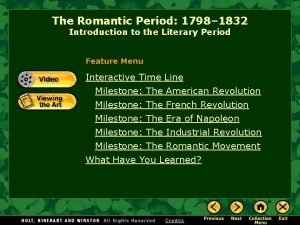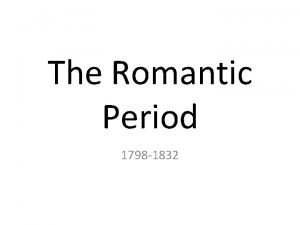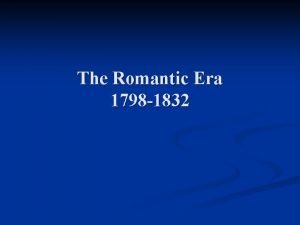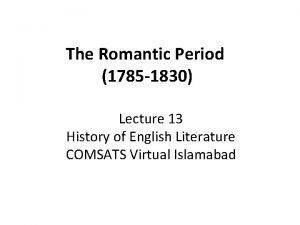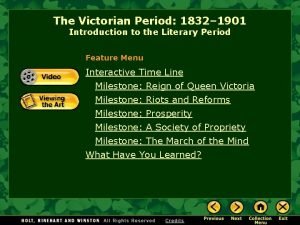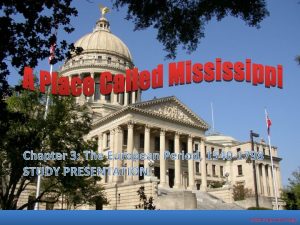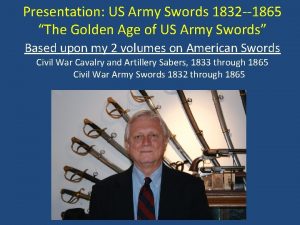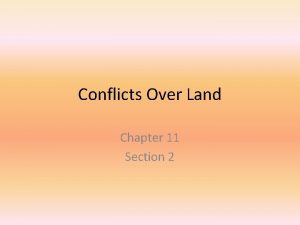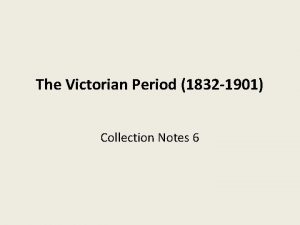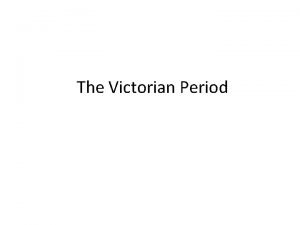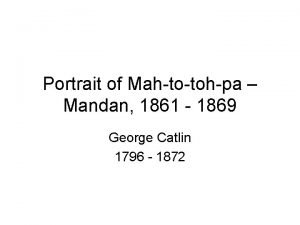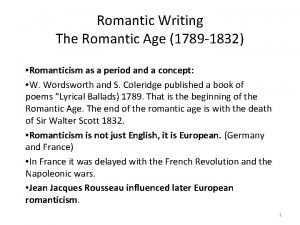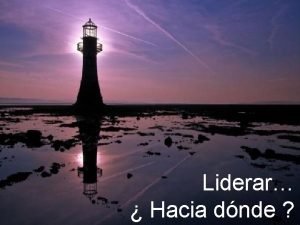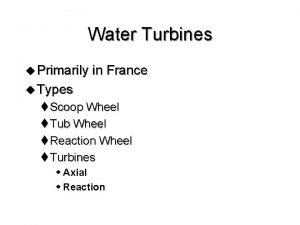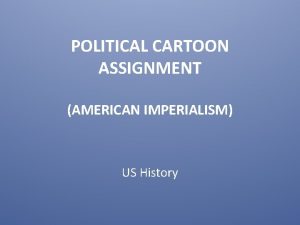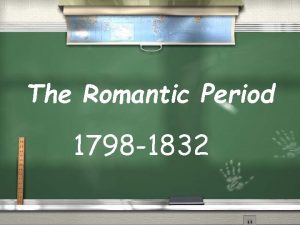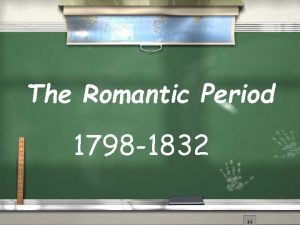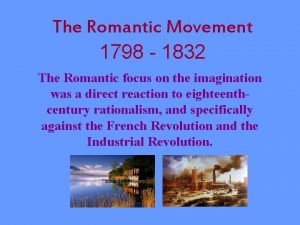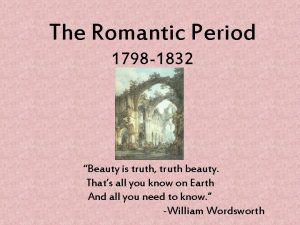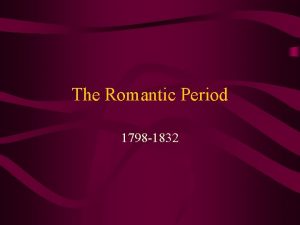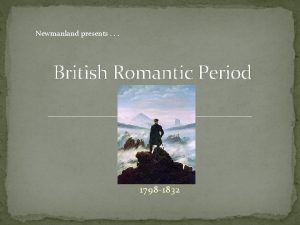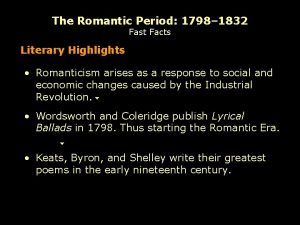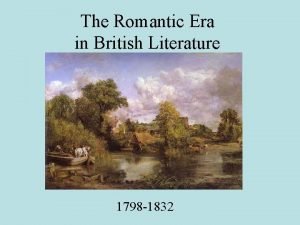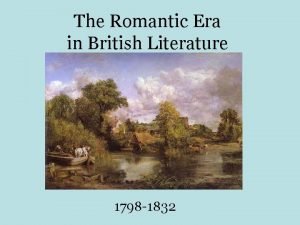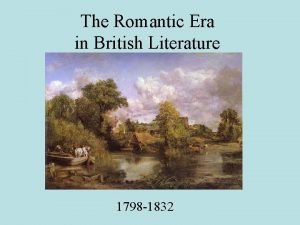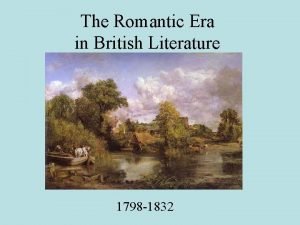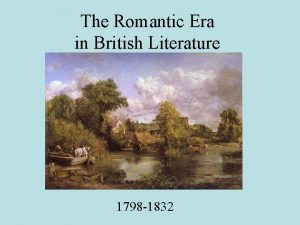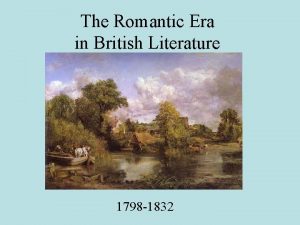The Romantic Period 1798 1832 The Romantic Period




















- Slides: 20

The Romantic Period 1798 -1832

The Romantic Period Sign of the Romantic Age was the publication of the joint work by William Wordsworth (17701850) and Samuel Taylor Coleridge (1772 -1834) – Lyrical Ballads (1798) Characterized by its personal nature, its strong use of feeling, its abundant use of symbolism and its exploration of nature and the supernatural.

The Romantic Period Name: derived from “romance” – the literary form in which desires and dreams prevail over everyday realities.

In this work, Wordsworth laid down the principles on which he thought the composition of poetry should be founded: • The language of poetry should be the language of ordinary men and women, found in the unspoilt speech of the rural people. • He was against “poetic diction. ” • He was against the rationalist content of the Neoclassical Age. • He wanted to return to imagination, legend, and the human heart of the Elizabethans.

The Romantic Period • He believed the poetry was more than the versification of philosophical truths: the poet was a prophet, not the transcriber of other men’s truths but the initiator of truth itself: “Poets are the trumpets which sing to battle; poets are the unacknowledged legislators of the world” (Percy Shelly) • The exploitation of the supernatural and of “the far away and the long ago” • The use of poetic symbolism deriving from a world view in which objects are charged with a significance beyond their physical qualities. “I always seek in what I see the likeness of something beyond the present and tangible object” (Percy Shelly)

The Romantic Period • External nature – the landscape, together with its flora and fauna – became a persistent subject of poetry and was described with accuracy unprecedented in earlier writers. • Nature is not presented for its own sake, but only as a stimulus for the poet to engage in thinking. • Romantic poems are in fact poems of feelingful meditation about central human problems.

William Wordsworth “In nature resides God” • Called the poet of nature because nature meant more to him than all the systems; his attitude to nature is original and remarkable. • To him, nature is the great teacher of morals, the prime bringer of happiness. • He is in constant contact with nature: woods, mountains, lakes and trees. • He is neither Christian nor rationalist. He is a Pantheist, one who identifies the natural universe with God, thus denying that God possesses a distinct quality. • This worship of nature leads him to respect simple folk: they are purer, wiser than town-dwellers, and their language is less corrupt.


William Wordsworth The birds around me hopped and played, Their thoughts I cannot measure: But the least motion which they made, It seemed a thrill of pleasure. The budding twigs spread out their fan, To catch the breezy air; And I must think, do all I can, That there was pleasure there. (Tintern Abbey)

Samuel Coleridge • Coleridge’s contribution lay in a return to the magical and mysterious. • Due to this, he and Wordsworth could never see eye to eye. • Makes mysterious and supernatural events acceptable to a reader’s mind. E. g. The Rime of the Ancient Mariner, Kubla Khan and Christabel.


The Romantic Period George Gordon-Lord Byron (1788 -1824): romantic figure, but his poetry was much influenced by the classical form of Dryden and Pope (Heroic couplets). Poetry: powerful, but lacks poetic imagination. Words mean what they say (literal) and have no magic. Verses lack Wordsworth’s power of suggestion and Coleridge’s mystery. Prose: influenced by 18 th century, but his satires lack Pope’s polished perfection and command of words. His poetry had an influence on Romanticism.

The Romantic Period • Poems: Childe Harold (1809 -17) – Spenserian stanza – adventure of a young man who travels far. (main character: Lord Byron) • 1812 and onwards: Narrative Poems • Don Juan (1818 -24): long satirical poem attacking Byron’s enemies. • Poems: popular because they attacked false ideas and because they projected the eastern scene which was unfamiliar in his time.

The Romantic Period • Romantic Poets: - John Keats (1795 -1821): La Belle Dame san Merci - Percy Bysshe Shelley (1792 -1822): The Spirit of Solitude - Thomas Campbell (1777 -1844): The Battle of Baltic

Essayists The two major literary critics were: • Charles Lamb (1775 -1834) specialized in literary criticism in attempts to popularize the new poets in a form called the Essays of Elia • Thomas De. Quincey (1785 -1859) wrote Reminiscences of the English Lake Poets, which is full of interesting and shrewd assessments of the characters of the great Romantics like Wordsworth and Coleridge.

Novel The major novelist of this time was Jane Austen. • The reputation of Jane Austen (1775 -1817) has never been higher because her novels have a freshness, humor and delicacy not found in other novelists. • She is the first important woman novelist: Sense and Sensibility, Pride and Prejudice, Mansfield Park, Emma, Northanger Abbey, and Persuasion.


Jane Austen • She shows a small corner of English society as it was in her day: the little world of the moderately well-to-do county families. • Her primary interest is people, not ideas. • Her achievement lies in the meticulously exact presentation of human situations, the description of characters who are really living creatures, with faults and virtues mixed as they are in real life. • Her plots are straightforward; there is little action.

The Romantic Period 17 th-18 th Century Poetry 19 th Century Poetry Traditionalism in the materials, forms and style of literature. The prevailing attitude preferred innovation. The basic neoclassic rule of “Decorum, ” which asserted that the serious genres should deal with high subjects in an appropriately elevated style. The serious or tragic treatment of lowly subjects in common language. Composition: Artful manipulation of means to foreseen ends and artificial rules and conventions. Composition: Wordsworth described good poetry as “the spontaneous overflow of powerful feelings. Poetry about other people. Poetry about the poets themselves. Limited aims with inherited rules and imposed restrictions. Age of new beginnings and high possibilities. A person is a being of limitless aspiration toward the infinite good envisioned by the poet’s faculty of imagination. Regarded poetry writing as spare-time gentlemanly hobby. Regarded poetry writing as a job, profession.

Permission Acknowledgment My sincere appreciation goes to Ms. Ashwaq Basnawi for her generous permission to use her slides for LANE 341 course.
 Romantic period 1798 to 1832
Romantic period 1798 to 1832 1798-1832
1798-1832 Romantic period 1798 to 1832
Romantic period 1798 to 1832 The romantic period 1798 to 1832
The romantic period 1798 to 1832 The romantic period 1798 to 1832 summary
The romantic period 1798 to 1832 summary Romantic period timeline
Romantic period timeline The romantic age (1798 to 1824)
The romantic age (1798 to 1824) Victorian period of literature
Victorian period of literature The victorian period (1832–1901)
The victorian period (1832–1901) Chapter 3 the european period answers
Chapter 3 the european period answers This period lasted from approximately 1775 - 1825
This period lasted from approximately 1775 - 1825 Model 1832 dragoon saber
Model 1832 dragoon saber In 1832 the sauk chieftain
In 1832 the sauk chieftain Victorian age 1832 to 1901
Victorian age 1832 to 1901 The victorian age 1832 to 1901 unit test
The victorian age 1832 to 1901 unit test George catlin self portrait
George catlin self portrait Bolton romanticism amp; politics 1789 1832 download
Bolton romanticism amp; politics 1789 1832 download Sans arc lakota
Sans arc lakota Salmo 1832
Salmo 1832 1832
1832 Imperialism political cartoon
Imperialism political cartoon

